Galaxies 2
Most pics courtesy of NASA
At the Center of the Milky Way
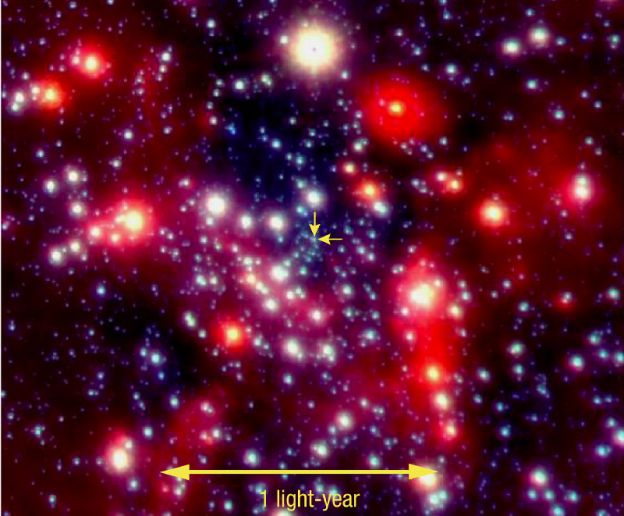

Explanation: At the center of our Milky Way Galaxy lies a black hole with over 2 million times the mass of the Sun. Once a controversial claim, this astounding conclusion is now virtually inescapable and based on observations of stars orbiting very near the galactic center. Using one of the Paranal Observatory's very large telescopes and the sophisticated infrared camera NACO, astronomers patiently followed the orbit of a particular star, designated S2, as it came within about 17 light-hours of the center of the Milky Way (17 light-hours is only about 3 times the radius of Pluto's orbit). Their results convincingly show that S2 is moving under the influence of the enormous gravity of an unseen object which must be extremely compact -- a supermassive black hole. This deep NACO near-infrared image shows the crowded inner 2 light-years of the Milky Way with the exact position of the galactic center indicated by arrows. NACO's ability to track stars so close to the galactic center can accurately measure the black hole's mass and perhaps even provide an unprecedented test of Einstein's theory of gravity as astronomers watch a star orbit a supermassive black hole.
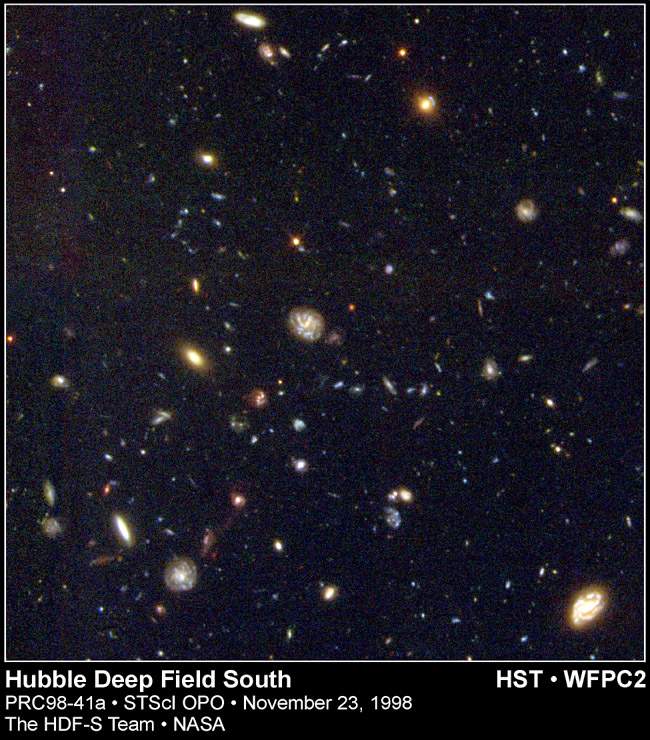
Explanation: This deep view of the cosmos is the sequel to the 1995 hit Hubble Space Telescope Deep Field. Billed as the Hubble Deep Field South, it was produced by pointing the space telescope toward a patch of sky in the southern constellation Tucana. Over a period of 10 days, many separate exposures were accumulated and combined to reveal progressively fainter galaxies. The original deep field was constructed by observing a piece of sky in the northern constellation Ursa Major. Both stare down 12 billion light-year long tunnels to far-off and still mysterious times when young galaxies inhabited an infant universe. Hubble Deep Field South observations were released to an enthusiastic audience on November 23, 1998.
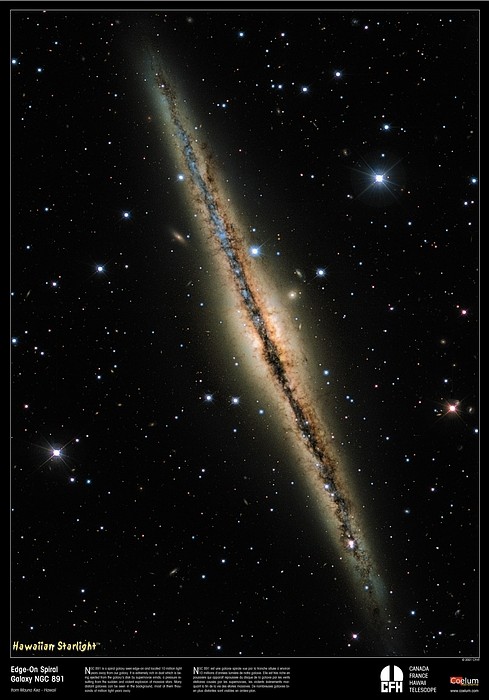
Explanation: What is going on in NGC 891? This galaxy appeared previously to be very similar to our own Milky Way Galaxy: a spiral galaxy seen nearly edge-on. However, recent high-resolution images of NGC 891's dust show unusual filamentary patterns extending well away from its Galactic disk. This interstellar dust was probably thrown out of the galactic disk toward the halo by stellar supernovae explosions. Because dust is so fragile, its appearance after surviving disk expulsion can be very telling. Newly discovered phenomena, however, sometimes appear so complex that more questions are raised than are answered.
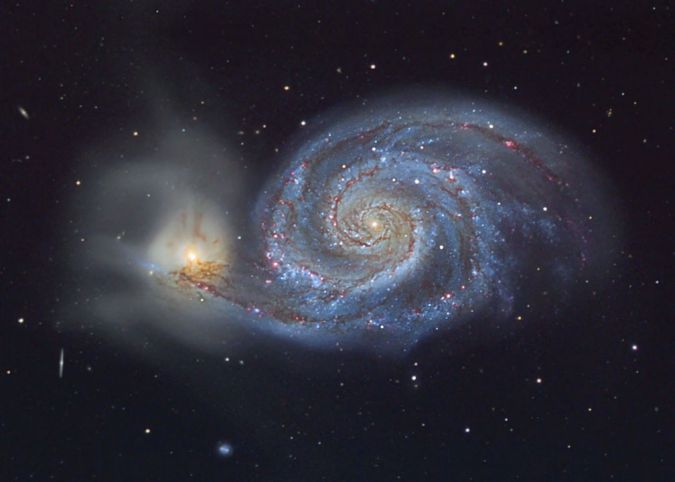
Explanation: Follow the handle of the Big Dipper away from the dipper's bowl, until you get to the handle's last bright star. Then, just slide your telescope a little south and west and you'll likely find this stunning pair of interacting galaxies, the 51st entry in Charles Messier's famous catalog. Perhaps the original spiral nebula, the large galaxy with well defined spiral structure is also cataloged as NGC 5194. Its spiral arms and dust lanes clearly sweep in front of its companion galaxy (left), NGC 5195. The pair are about 37 million light-years distant and officially lie within the boundaries of the small constellation Canes Venatici. While M51 is visible as a faint, fuzzy patch in binoculars, this sharp color picture was made with a 14 inch telescope and combines digital camera exposures totaling 3 hours and 42 minutes.
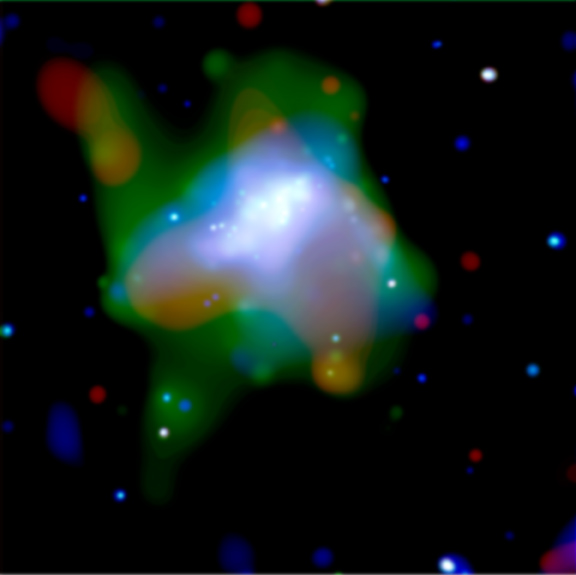
Explanation: For astronomers, elements other than hydrogen and helium are sometimes considered to be simply "heavy elements." It's understandable really, because even lumped all together heavy elements make up an exceedingly small fraction of the Universe. Still, heavy elements can profoundly influence galaxy and star formation ... not to mention the formation of planets and people. In this tantalizing false-color x-ray image from the orbiting Chandra Observatory, small dwarf galaxy NGC 1569 is surrounded by x-ray emitting clouds of gas thousands of light-years across. The gas has recently been observed to contain significant concentrations of astronomers' heavy elements such as oxygen, silicon, and magnesium, supporting the idea that dwarf galaxies, the most common type of galaxy in the Universe, are largely responsible for heavy elements in intergalactic space. A mere 7 million light-years distant toward the long-necked constellation Camelopardalis, NGC 1569 has undergone a recent burst of star formation and stellar supernova explosions. The furious cosmic activity has heated the expanding gas clouds to temperatures of millions of degrees while enriching them with newly synthesized heavy elements.
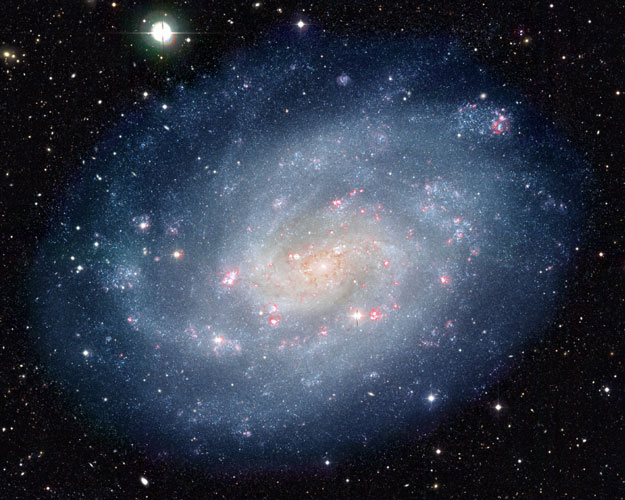
Explanation: NGC 300 is so interesting because it is so normal. An Sc-type spiral galaxy in the nearby Sculptor group of galaxies, NGC 300 shows typical flowing blue spiral arms, an expected compact nucleus, and the requisite amount of stars, star clusters, and nebulae. Therefore, studying NGC 300 should indicate how, exactly, a normal spiral galaxy works. Toward this goal, NGC 300 and the surrounding area were studied in exquisite detail, creating and combining a series of high-resolution images to create the above conglomerate picture. NGC 300 lies only 7 million light years away, spans nearly the same amount of sky as the full moon, and is visible with a small telescope toward the constellation of Sculptor.
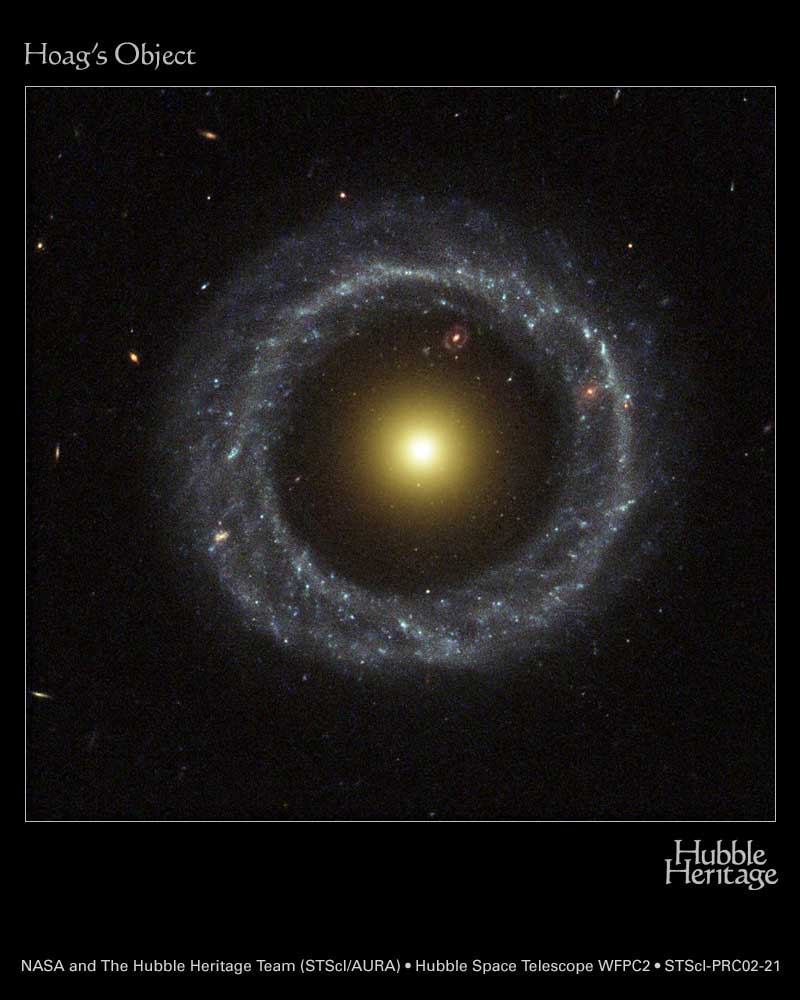
Explanation: Is this one galaxy or two? This question came to light in 1950 when astronomer Art Hoag chanced upon this unusual extragalactic object. On the outside is a ring dominated by bright blue stars, while near the center lies a ball of much redder stars that are likely much older. Between the two is a gap that appears almost completely dark. How Hoag's Object formed remains unknown, although similar objects have now been identified and collectively labeled as a form of ring galaxy. Genesis hypotheses include a galaxy collision billions of years ago and perturbative gravitational interactions involving an unusually shaped core. The above photo taken by the Hubble Space Telescope in July 2001 reveals unprecedented details of Hoag's Object and may yield a better understanding. Hoag's Object spans about 100,000 light years and lies about 600 million light years away toward the constellation of Serpens. Coincidentally, visible in the gap (at about one o'clock) is yet another ring galaxy that likely lies far in the distance.
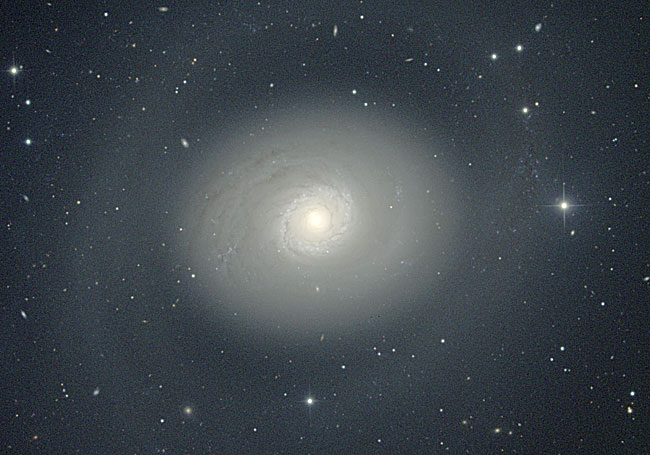
Explanation: What could cause the center of M94 to be so bright? Spiral galaxy M94 has a ring of newly formed stars surrounding its nucleus, giving it not only an unusual appearance but also a strong interior glow. A leading progenitor hypothesis holds that an elongated knot of stars known as a bar rotates in M94 and has generated a burst of star formation in the form of an outward moving ring. M94, pictured above digitally sharpened, spans about 30,000 light years, lies about 15 million light years away, and can be seen with a small telescope toward the constellation of Canes Venatici.
|